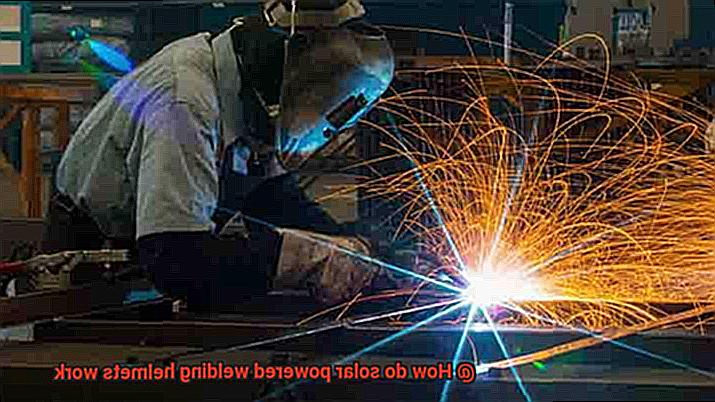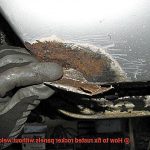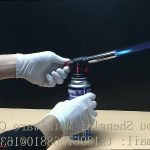Are you curious about how welders protect their eyes from the intense light produced during welding?
Look no further than welding helmets, also known as shields. These essential pieces of equipment shield welders from harmful ultraviolet and infrared rays that welding arcs emit.
Solar-powered welding helmets have become increasingly popular in recent years due to their user-friendly and efficient design. The secret behind solar-powered welding helmets lies in their automatic darkening lenses or ADFs.
These lenses adjust the shade of the helmet’s lens based on the intensity of the welding arc, providing optimal eye protection for welders. When not in use, these lenses lighten up, but as soon as the welding arc starts, they automatically darken to a level that ensures maximum safety.
This means that welders can work comfortably without having to constantly flip their helmets up and down. The solar panels integrated into the welding helmet’s lens provide power, eliminating the need for replacement batteries.
Not only is this environmentally friendly, but it’s also cost-effective for welders. Additionally, solar-powered welding helmets come with adjustable sensitivity and delay settings, adding an extra layer of safety for welders.
With their advanced technology and practical features, they provide an easy-to-use solution for welders looking to protect their eyes while on the job.
How do Solar Powered Welding Helmets Work?
Contents
- 1 How do Solar Powered Welding Helmets Work?
- 2 Advantages of Solar Powered Welding Helmets
- 3 How to Charge a Solar Powered Welding Helmet
- 3.1 How Do Solar Powered Welding Helmets Work?
- 3.2 How Long Does It Take To Charge A Solar Powered Welding Helmet?
- 3.3 How Frequently Do Solar Powered Welding Helmets Need To Be Charged?
- 3.4 What Should I Do If My Welding Helmet Is Not Charging Properly?
- 3.5 How Do I Take Care Of My Solar Powered Welding Helmet’s Battery?
- 4 Charging a Solar Powered Welding Helmet Indoors or on Cloudy Days
- 5 Backup Battery for Solar Powered Welding Helmets
- 6 Maintaining and Caring for a Solar Powered Welding Helmet
- 7 Conclusion
If you’re someone who’s interested in welding, you know it’s a process that requires precision and care, particularly when it comes to safeguarding your eyes.
And that’s where solar powered welding helmets come in. These helmets are becoming increasingly popular in the welding industry due to their convenience, reliability, and protection.
So, how do they work? Let’s explore.
The first thing that sets solar powered welding helmets apart from traditional ones is their use of solar panels and batteries to power the auto-darkening lens. The solar panels are located on the outer shell of the helmet and absorb sunlight, converting it into electrical energy that is stored in the helmet’s battery.
When the welder initiates an arc, this stored energy is then used to power the auto-darkening lens. The auto-darkening lens protects the welder’s eyes from harmful ultraviolet (UV) and infrared (IR) radiation emitted during welding.
It’s made up of liquid crystal displays (LCDs) coated with a thin layer of polarizing material. When sensors in the helmet detect the bright light from welding, they signal the LCDs to darken within milliseconds.
One of the most significant advantages of using a solar powered welding helmet is that it eliminates the need for frequent battery replacements. As long as there is enough sunlight, the helmet will continuously charge and provide power to the auto-darkening lens.
Furthermore, these helmets are more portable and convenient since there are no cords or wires required for charging. To charge a solar powered welding helmet, all you have to do is place it in direct sunlight with the lens facing up.
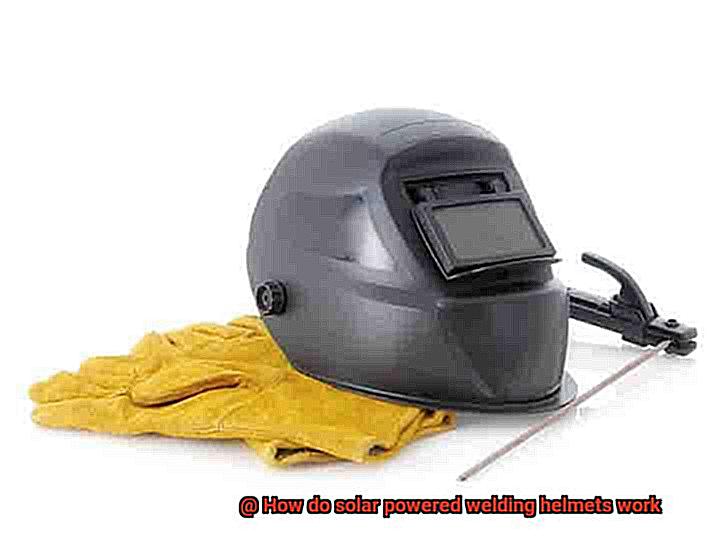
It takes around 6-8 hours of direct sunlight to fully charge the helmet. On cloudy days or if you need to charge the helmet indoors, you can also use a USB cable to connect it to a power source.
Most solar powered welding helmets come with adjustable sensitivity and delay settings that allow welders to customize their helmets for different types of welding projects. The sensitivity setting determines how much light is needed to activate the auto-darkening lens, while the delay setting controls how quickly the lens goes from dark back to light after welding is complete.
They work by using solar panels to convert sunlight into electricity, which is then used to power the auto-darkening lens.
Advantages of Solar Powered Welding Helmets
Solar powered helmets have been gaining popularity among welders due to their numerous advantages. Let’s take a closer look at some of the benefits of using solar powered welding helmets.
First and foremost, solar powered welding helmets are cost-effective in the long run. Unlike traditional helmets, solar powered ones do not require batteries or electricity to operate.
This means you can say goodbye to the hassle and expense of replacing batteries or paying for electricity bills.
Another advantage of solar powered welding helmets is their convenience.
No more fussing with turning your helmet on and off – these helmets automatically turn on when you begin welding and turn off when you stop. This allows you to keep your focus where it should be – on your work.
Solar powered welding helmets also provide better vision than traditional helmets.
With auto-darkening lenses that adjust based on the intensity of the welding arc, you’ll always have a clear view of your workpiece. This is crucial for precision welding and can lead to improved quality of work.
Perhaps most importantly, solar powered welding helmets offer improved safety for welders. They protect your eyes and face from harmful UV and IR radiation emitted during welding, reducing the risk of eye strain, fatigue, and accidents.
Overall, it’s clear that solar powered welding helmets are a wise investment for any welder. They offer cost-effectiveness, convenience, better vision, and improved safety.
How to Charge a Solar Powered Welding Helmet
As a welder, you need to have a reliable and durable helmet that can protect your eyes from harmful rays while providing clear visibility of your work. A solar powered welding helmet is an excellent choice for this purpose, but what do you need to know about charging it?
Here, we will cover some information to help you understand how to charge your solar powered welding helmet.
How Do Solar Powered Welding Helmets Work?
Solar powered welding helmets use solar panels on the outer shell to capture sunlight or any other light source that has enough intensity.
The solar panels then convert the captured light energy into electrical energy, which is stored in a rechargeable battery inside the helmet. This stored energy powers the auto-darkening filter when you initiate an arc.
How Long Does It Take To Charge A Solar Powered Welding Helmet?
The time required to fully charge a solar powered welding helmet depends on the intensity of the light source and the capacity of the battery. Typically, it takes 2-3 hours of direct exposure to sunlight to fully charge a welding helmet. If you are using a weaker light source, it may take longer to charge.
How Frequently Do Solar Powered Welding Helmets Need To Be Charged?
Solar powered welding helmets do not require frequent charging as they have a long battery life. The battery inside the welding helmet can last for several years depending on usage and maintenance. However, if you notice that your helmet’s auto-darkening filter is not functioning correctly or if the battery indicator shows low charge, it may be time to recharge your helmet.
What Should I Do If My Welding Helmet Is Not Charging Properly?
If you find that your welding helmet is not charging correctly, there could be an issue with either the solar panel or the battery. In this case, refer to the user manual or contact the manufacturer for assistance. They will be able to diagnose and fix any issues with your helmet.
How Do I Take Care Of My Solar Powered Welding Helmet’s Battery?
To maintain your solar powered welding helmet’s battery, keep the solar panel clean and free from debris or dust that could block sunlight from reaching it.
Store your welding helmet in a cool and dry place when not in use to prevent damage to the battery or other components. Over time, batteries can lose their ability to hold a charge and may need replacement. If you need to replace the battery in your welding helmet, consult the manufacturer’s instructions or seek professional assistance.
So, charging a solar powered welding helmet is simple and requires only exposure to light. By understanding how these helmets work and implementing proper maintenance techniques, you can ensure that your welding helmet provides reliable protection and visibility for many years.
Charging a Solar Powered Welding Helmet Indoors or on Cloudy Days
As a welder, you know how important it is to have a welding helmet that can protect your eyes and face from the intense light and heat of welding.
With the innovative technology of solar-powered welding helmets, you can have continuous protection without needing external power sources. But what do you do when you need to charge it on cloudy days or indoors?
Don’t worry, we’ve got you covered. Solar-powered welding helmets are designed with a solar panel that captures energy from the sun and converts it into electrical energy to power the auto-darkening lens.
To recharge the battery, all you need to do is expose the helmet to direct sunlight or any other bright light source. The solar panel will absorb the light and convert it into electrical energy that stores in the rechargeable battery.
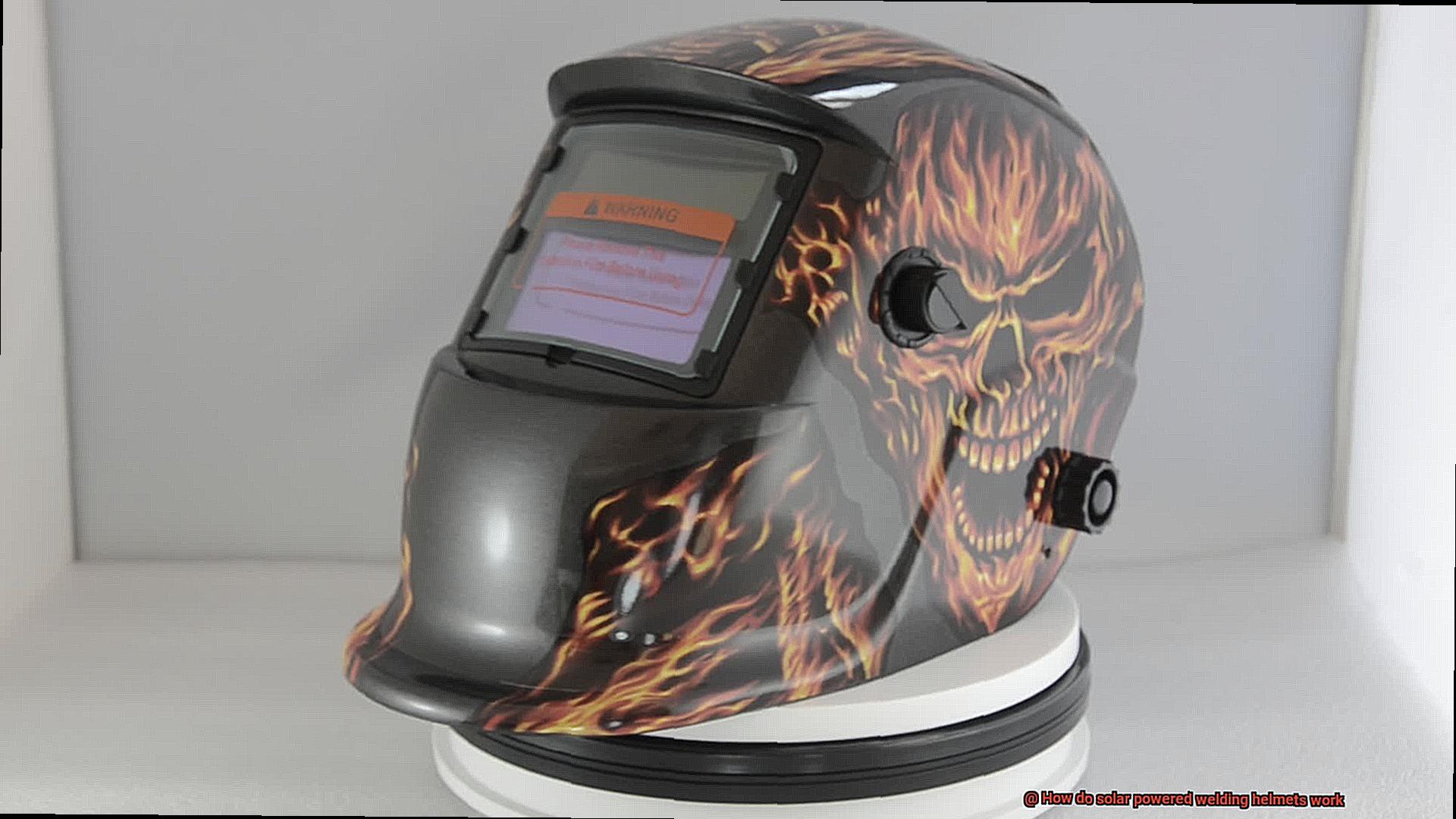
Charging time may vary depending on the amount of sunlight or light source available. In ideal conditions, it should take about two hours for the battery to fully charge.
However, if you’re working indoors or in an area with minimal sunlight, it may take longer to charge. In such cases, we recommend keeping the helmet in a brightly lit area or near a window where it can receive as much natural light as possible.
Alternatively, you can use a bright artificial light source like a halogen lamp or LED light to charge your helmet. It’s crucial to ensure that your solar-powered welding helmet is fully charged before using it.
Insufficient charge may result in reduced performance and shorter battery life. It’s also important to store your helmet in a cool, dry place and avoid exposing it to extreme heat or moisture that can damage its sensitive electronic components.
Not only do they provide uninterrupted service on job sites where electricity may not always be available, but they’re also easy to use and maintain.
Backup Battery for Solar Powered Welding Helmets
That’s where a backup battery for your solar-powered welding helmet comes into play – it’s like having a reliable safety net.
The backup battery is a small yet powerful source of energy that helps extend the life of your welding helmet’s battery. It’s the kind of backup you’ll be glad to have in case your helmet battery dies unexpectedly.
After all, running out of power during a critical welding task can put your work and safety at risk. Typically, the backup battery is a lithium-ion battery that can be charged using either a USB port or solar panel.
The battery is located inside the helmet and can be replaced easily when needed. To charge it, simply connect it to a power source or expose it to direct sunlight using the solar panel.
But why is it so important to have a backup battery? For starters, it ensures that your auto-darkening feature works reliably.
This feature needs a steady flow of power to function correctly, and having a backup battery keeps the power supply constant and uninterrupted. If you neglect to charge the backup battery regularly, its charge capacity may decrease over time.
That’s why it’s important to keep your backup battery fully charged and ready for use whenever you need it. In conclusion, investing in a backup battery for your solar-powered welding helmet is essential for uninterrupted welding sessions.
Maintaining and Caring for a Solar Powered Welding Helmet
You know firsthand how critical it is to keep your helmet in tip-top shape.
Proper maintenance and care will ensure that your helmet lasts long and delivers the performance you need for seamless welding sessions. One of the most important steps in maintaining your solar-powered welding helmet is cleaning the lens regularly.
The lens is your primary window to the world, and it can accumulate dirt, debris, and spatter during welding, which can obscure your vision. To avoid this, use a soft cloth or lens cleaning solution to clean the lens regularly.
Avoid using abrasive materials that can scratch or damage it. Another crucial aspect of maintaining a solar-powered welding helmet is keeping it dry and away from moisture.
Moisture can wreak havoc on the solar cell and battery components of the helmet, reducing its lifespan and performance. Therefore, store your helmet in a dry place when not in use and avoid exposing it to rain, snow, or other forms of precipitation.
To ensure that your helmet functions correctly, make sure to charge it regularly. Most solar-powered helmets come with an auto-darkening feature that requires the battery to be charged periodically.
The time required for charging may vary depending on the model of the helmet and the frequency of usage. Typically, eight hours of exposure to sunlight can fully charge the battery.
If you need to charge your helmet indoors, place it near a bright light source or under a lamp that emits UV rays. Some helmets may come with a USB port that allows charging through a computer or power bank.
Lastly, replacing the battery in your solar-powered welding helmet is an essential maintenance task that you don’t want to overlook. While most helmets have non-replaceable batteries that last for several years, some models may require battery replacement after a few years of usage.
Consult the user manual for specific instructions on replacing the battery or take it to a professional repair shop for assistance.
oYTDlhcetFg” >
Conclusion
To sum it up, solar-powered welding helmets have revolutionized the welding industry with their user-friendly and efficient design.
The secret behind their popularity is the automatic darkening lenses or ADFs that adjust the shade of the lens based on the intensity of the welding arc, providing optimal eye protection for welders. And with integrated solar panels, these helmets are environmentally friendly and cost-effective since they eliminate the need for replacement batteries.
But wait, there’s more. These helmets also offer adjustable sensitivity and delay settings that allow welders to customize their helmets for different types of welding projects.
Plus, they provide better vision than traditional helmets with auto-darkening lenses that only adjust based on the intensity of the welding arc. Proper maintenance is crucial to ensure your solar-powered welding helmet performs at its best.
It’s important to regularly clean and keep the lens dry and away from moisture, charge it periodically, and replace its battery when necessary. Investing in a backup battery is also essential for uninterrupted welding sessions.
In conclusion, upgrading to a superhero-like solar-powered helmet is worth it if you want reliable protection and visibility for many years to come.
